What is the World's First Refrigerator Ever Made - History in Timeline
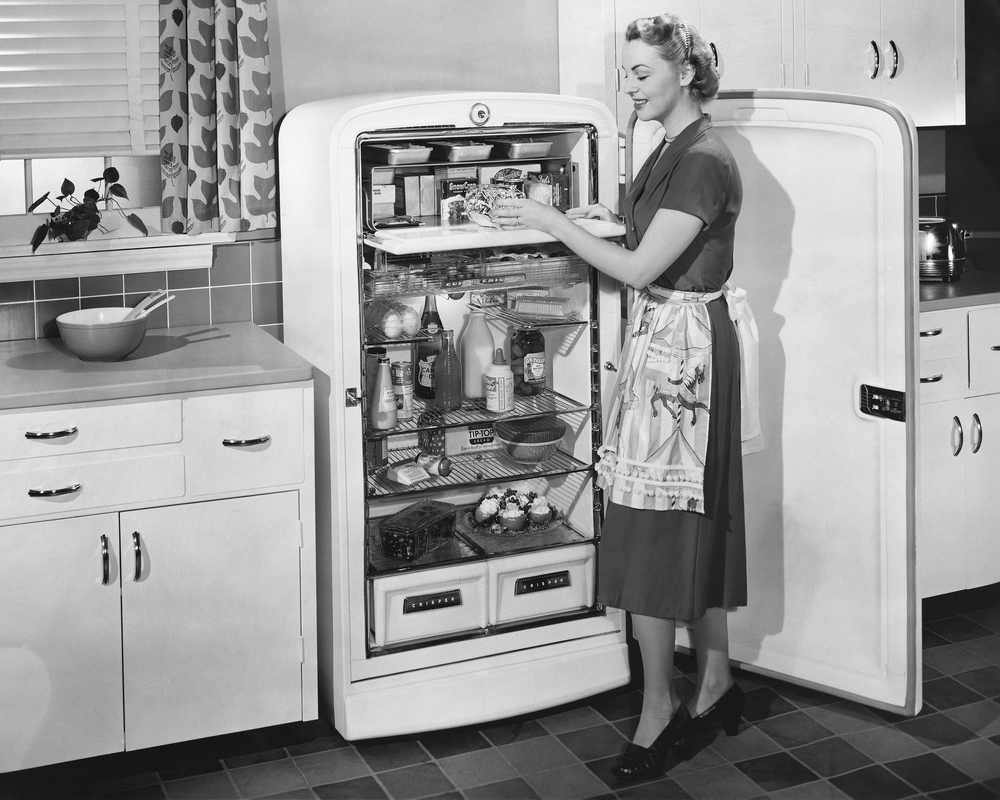 |
| Photo: Live Science |
| Table of Content |
If you’ve ever been without power in your house, you know just how suddenly keeping the food in the refrigerator cold becomes a necessity. Can you imagine living in a time before refrigerators? Warm summer months meant that families would gamble with safe food consumption, and any families living in poverty were rarely able to afford ice.
From ancient ice houses to today’s Internet-connected fridges – take a tour through the history and development of the refrigerator.
What is the First and Oldest Refrigerator in the World?
Scientists ind the world continue to argue about the world's first refrigerator.
However, most scientists recognize that the first real electric refrigerator used in the home was the Domelre, born in 1913 by the American inventor.
Since ancient times, the inhabitants of temperate regions had the idea of preserving food in a cold environment. Scientists discovered that a few thousand years ago, Turkish kings loved to eat "sherbet", a type of syrup with added snow.
In the days of Alexander the Great, it was known to chill fruit in the snow.
In China, frozen fruit juices have been popular since the 12th century.
Thus, the idea of creating a cold environment to preserve food has been around since ancient times, but it was not until the 18th century that people could implement this idea by placing it in a closed cabinet. ice cubes and change them often to keep food longer.
Natural ice was an important commercial commodity until the early twentieth century. Traders took natural stones from cold countries, cut them in cupboards or deep cliffs.
But people's demand for ice is increasing day by day. Natural stone cannot be moved or left for a long time. How can ice be produced to replace natural ice? In 1859, a French engineer named Ferdinand Carré did just that.
His freezer was a breakthrough idea in human freezing technology. His ammonia refrigeration technique was later used worldwide in the industrial ice production field. A few years later, Charles Tellier crossed the Atlantic in the ship "Frigorifique", equipped with refrigeration units in the compartment. The lamb thighs preserved in the cabin still have not lost their distinctive flavor after a journey of nearly 3 months!
But it wasn't until 1913 that the first refrigerator for home use appeared: the Domelre refrigerator was built by Freda W. Wolf, from Chicago (USA). Demolre generates cold gas based on the principle of heat absorption. Water is heated, converted to steam, heat absorption starts to take place, the steam is cooled by the outside temperature and reverts back to a liquid state, which is then heated again…and so on. . They can keep foods longer without losing their taste. Returning to New York, he improved the refrigeration equipment, and by 1930, frozen foods were on the market.
In 1950, refrigerators were strongly commercialized and gradually became a necessity in homes.
What is Domelre - The First Electric Refrigerator in the World?
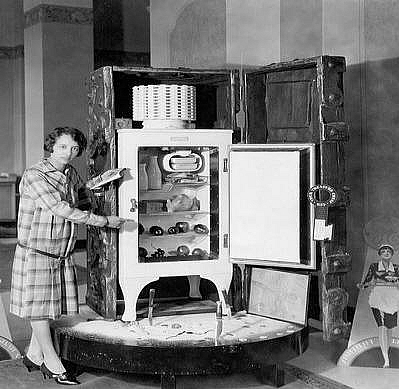 |
| DOMELRE - The in-home (first electric) refrigerator was born as the brainchild of Fred W. Wolf in 1913 |
The DOMELRE was the first successful, mass marketed package automatic electric refrigeration unit. Invented in 1913 by Fred W. Wolf Jr., charter member of American Society of Refrigerating Engineers.
The name DOMELRE is a contraction of DOMestic ELectric REfrigerator The DOMELRE was factory manufactured to be a ready-to-use refrigeration unit that could be delivered, mounted on top of an ice box and simply plugged in. Several thousand were sold between 1914 and 1922.
Wolf sold the DOMELRE rights to Henry Joy, president of Packard Motor Car Company in 1916, who marketed the refrigeration unit with improvements using the name ISKO. Isko was purchased in 1922 by Frigidaire who wanted Wolf’s patents to begin producing an air-cooled automatic refrigerator.
The model on display was produced in 1916 and may be the only DOMELRE still extant.
Who is Frederick William Wolf Jr. (1879-1954) - Inventor of the First Refrigerator?
Fred Wolf Jr. was born in Chicago, son of Fred W. Wolf who was a refrigeration engineer and architect specializing in brewery construction. Wolf Sr. obtained rights to manufacture and sell the Linde ammonia refrigeration system in the United States in 1878.
Fred Wolf Jr. became interested in the possibilities of applying mechanical refrigeration systems to merchants and homes and began promoting small refrigeration systems in the early 1900’s. Wolf joined the American Society of Refrigerating Engineers as a charter member. He attended early meetings of the ASRE and participated in discussions of papers presented at the meetings.
Besides refrigeration, Wolf was interested in automobiles, particularly race cars. Wolf’s grandson mentioned that Wolf built a number of autos of his own design and raced them. In fact, the Automobile Review reported that Wolf participated in an “endurance run” in August 1902 using a auto of his own manufacture.
Wolf was an engineer, designer and promoter “remembered for his eccentricities” who established different companies that developed, promoted and manufactured small sized refrigeration systems into the 1920’s. Some of the machines he designed were the DOMELRE, KOFAX and FRIDGER. Wolf secured a number of US patents for his designs. Little is known of his work after 1930. Wolf passed away in 1954.
History of Refrigerator: Story in A Timeline
1000 B.C., and 500 years
The Chinese cut and stored ice around 1000 B.C., and 500 years later, the Egyptians and Indians learned to leave earthenware pots out during cold nights to make ice.
Other civilizations, such as the Greeks, Romans and Hebrews, stored snow in pits and covered them with various insulating materials.
Chinese Ancient Refrigerator or Ice Container
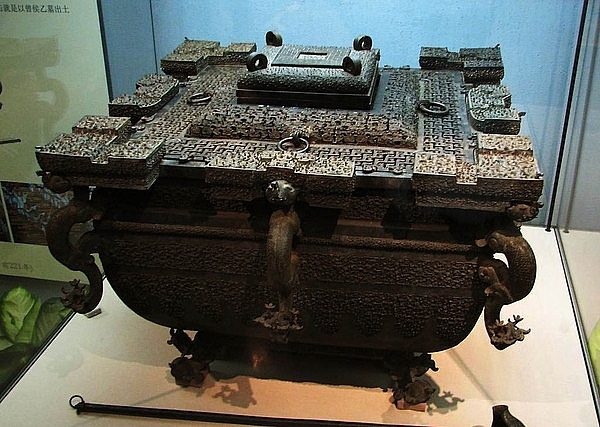 |
| Chinese Ancient Refrigerator |
Ancient Chinese already invented a mini ice house or ice container to keep wine cool in hot summer, this can be regarded as the earliest refrigerator in China.
The above instrument is called Jian, a bronze container from the Warring States Period (475-221BC). It has two layers and the inter-layer will be stuffed with ice to keep the wine cool.
In the late Qing Dynasty (1644 – 1912), the common people used ice bucket, which had similar function similar with modern refrigerators. They use wood to make the frame work and low heat conductivity metals of lead and tin to extend the time of ice use.
Refrigerator in the 1700s and 1800s
The basis for refrigerator appeared in 1755 when Scottish professor William Cullen designed a small refrigerating machine. This machine had a pump and a container of diethyl ether. The pump made a vacuum in the container which lowered the boiling point of the ether. Boiling ether absorbed the heat from the surrounding air, according to History of Refrigerator.
Next step in 1805 when American inventor Oliver Evans invented a closed vapor-compression refrigeration cycle again based on ether which had its boiling point lowered by vacuum. These ideas and prototypes were not practical until Jacob Perkins built the first working vapor-compression refrigeration system in the world in 1834. His system had a closed cycle and could operate without waste. Although practical, it did not succeed commercially.
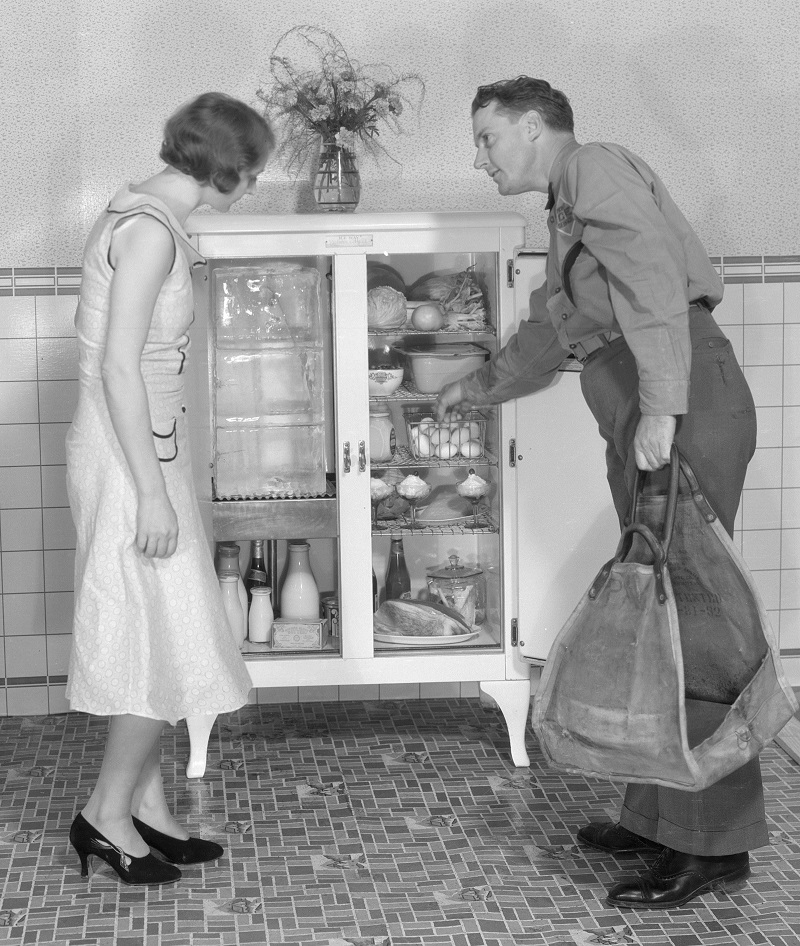 |
| Photo: National Museum of American History - Smithsonian Institution |
American physician John Gorrie built a working prototype in 1842 and planned to use it for cooling the air in the tropical homes, but this one was also a commercial failure. James Harrison, a British journalist who had immigrated to Australia, built a mechanical ice-making machine in 1851 and made the first commercial ice-making machine in 1854. He patented it in 1856. This machine used ether, alcohol or ammonia while later models used ammonia dissolved in water, sulfur dioxide, and methyl chloride. These refrigerators were also used in breweries and meatpacking houses.
1920’s - The invention of the electric refrigerator
Electric fridges were not yet mass-produced and were mainly owned by the wealthy, costing around USD 1,000. As the cost started to drop, the market expanded. Sales rose from 200,000 in 1926 to 1.5 million in 1935. By the mid-1930s, the number grew to around 6 million.
1922
Swedish inventors Baltzar von Platen and Carl Munters come up with the absorption refrigerator, which is put into mass production by AB Arctic in 1923. Two years later the company is acquired by Electrolux.
1927
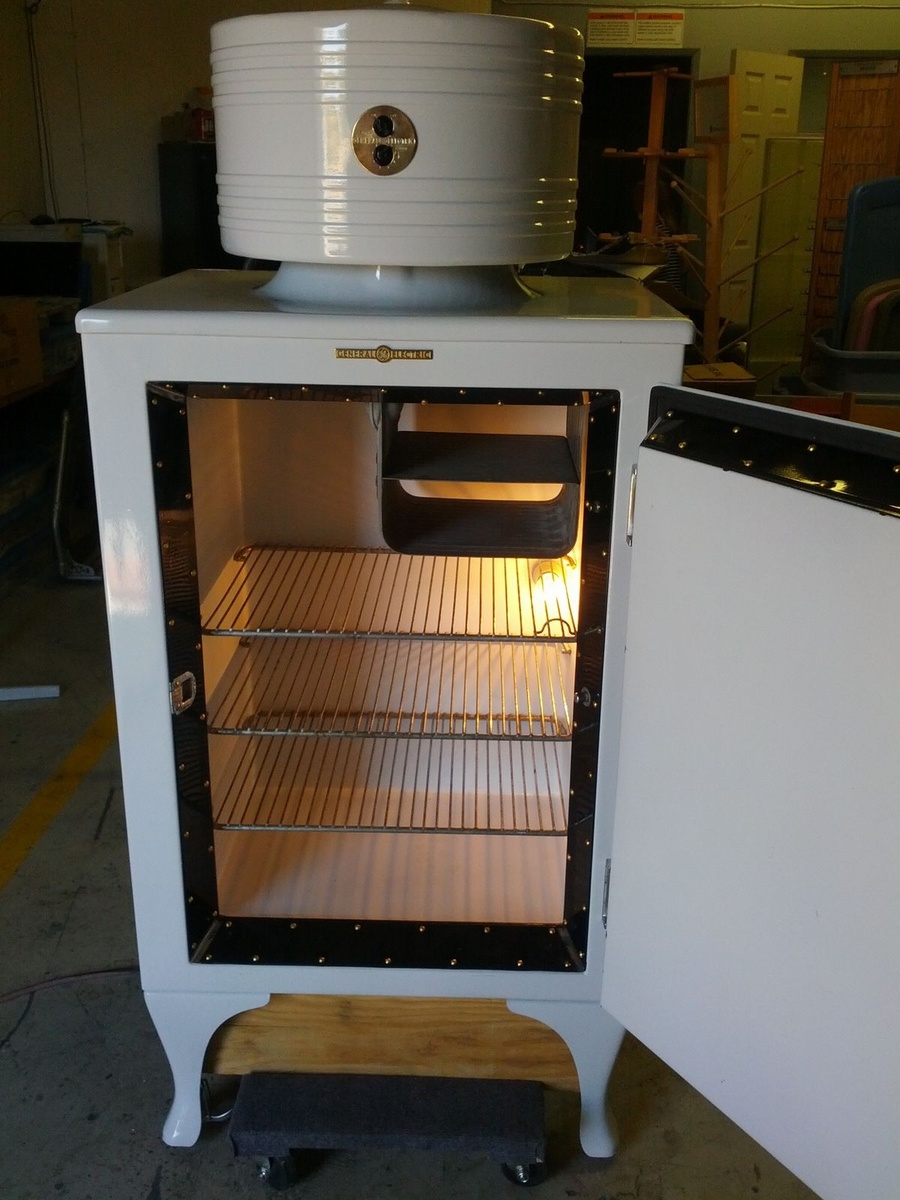 |
| “Monitor-Top” - the first refrigerator to be widely used. Photo: Collectors Weekly |
General Electric introduced the “Monitor-Top,” which became the first refrigerator to see widespread use – more than a million units were produced. The compressor assembly, which emitted a great deal of heat, was placed above the cabinet. These refrigerators used either sulfur dioxide or methyl formate as a refrigerant.
1930’s - The introduction of the freezer
Consumers were introduced to the concept of freezers when ice cube compartments became commonly available in electric refrigerators during the 1930’s. Refrigerator manufacturers during this decade also replaced Sulphur Dioxide with Freon 12 as the most commonly used refrigerant, Big Chill cites.
1940’s - A household mainstay
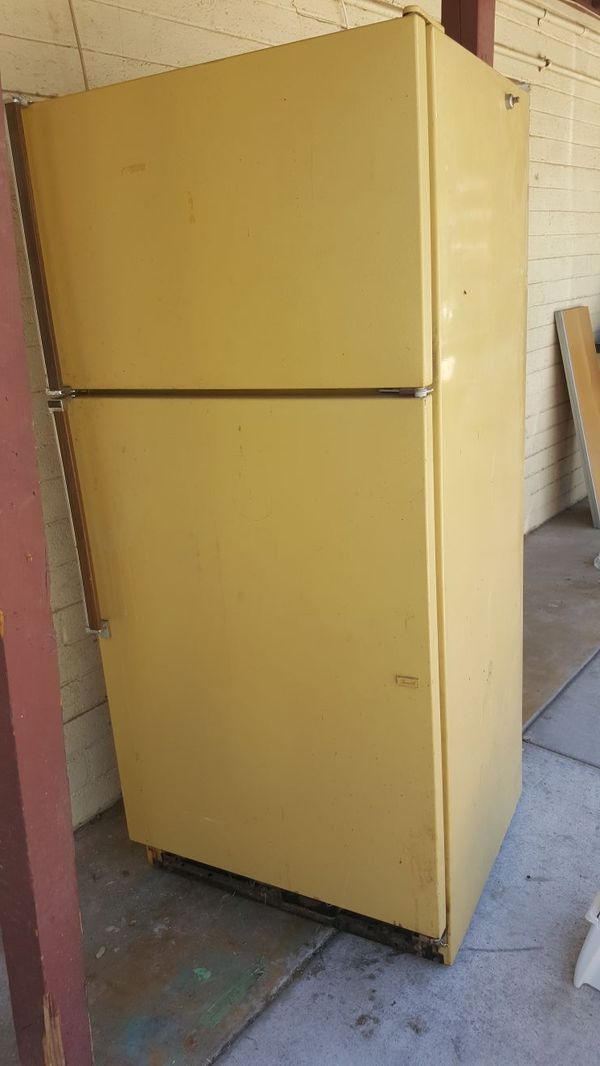 |
| Photo: OfferUp |
In the 1940’s, consumers utilized their chilly compartments as frozen food storage. During this period, fridges went mass market: by 1944, 85% of American households owned a refrigerator.
1950’s - The rise of the household fridge
The 1950s were a groundbreaking time for fancy refrigerator enhancements. At that time, refrigerators were marketed toward housewives and were a prideful addition to any household. A popular home design and the decorating scheme was to match your colorful refrigerator to the cupboards and walls of your kitchen. Refrigeration technology began to make significant advancements in the 1950s when game-changing innovations like automatic ice makers and automatic defrost began appearing on the scene. In many ways, this was period represented the height of fridge design - our Retro series celebrates this unique time.
1960’s- Futuristic design & big freezers
Household designs of the 1960’s reflected simple, yet futuristic looks with soft edges and design curves as can be seen in our Retropolitan Series. Refrigerators of the 60’s reflected this jump toward the future, hinting at a promising lifetime of domestic improvements and freedom. Freezer sizes were also increased in this decade, allowing hardworking moms to stock up on the booming food trend: frozen family dinners.
1970’s: A turn towards boxy and a focus on energy efficiency
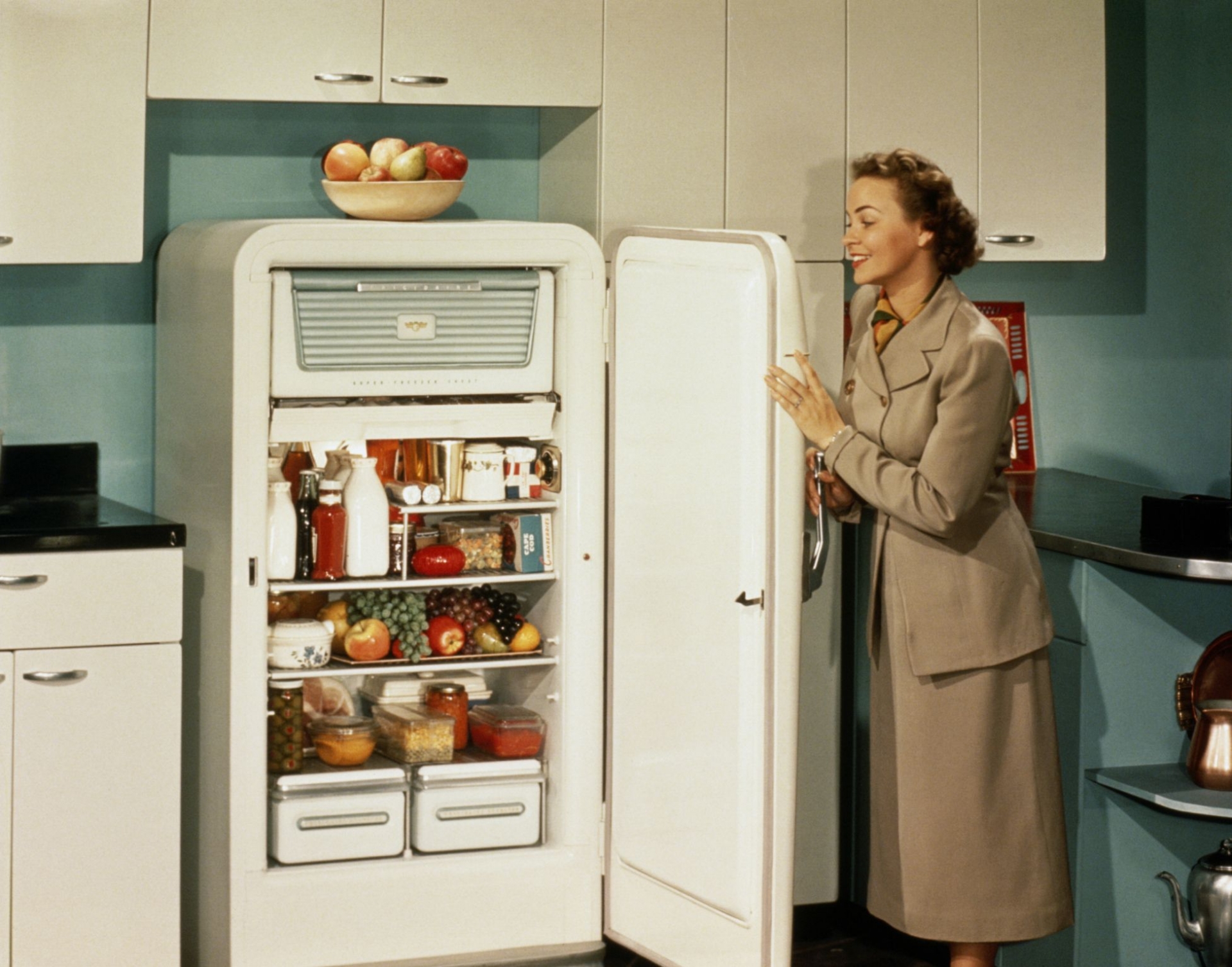 |
| Photo: Good Housekeeping |
Refrigerators in the 1970’s surprisingly took a turn back to the more boxy look of refrigerators in the 1940’s. The markets saw a rise in the popularity of compact and miniature fridges, and the environment became a top priority with the introduction of energy-efficient refrigerators and appliances to meet new standards put in place by various governments worldwide. A fridge in 1975 used about 2200 kWh/year of energy.
1980’s - Sturdy and utilitarian
Refrigerators built in the 1980’s were built to last, with new appliances featuring sturdy and utilitarian influenced designs. Homes of the 1980’s took on a more pragmatic design than decades past, and refrigerators were no exception to this. The elimination of chlorofluorocarbons in refrigerator sealed systems made refrigerators of this decade more safe and sensible in the eyes of manufacturers and consumers. A fridge in 1985 used about 1700 kWh of energy.
1990’s - French doors and stainless facades
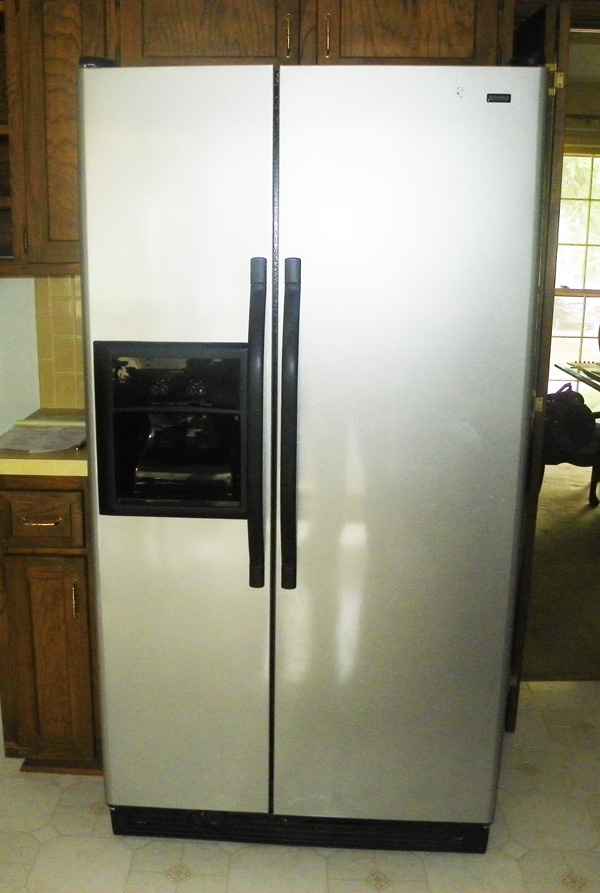 |
| Photo: Semper Fi Auction Services |
Appliance designs of 1990’s were aimed to be sleek and modern, with the introduction of French-style doors and stainless steel to refrigerator facades. Bulky white refrigerators of the past were gradually falling out of style, with consumers favoring more contemporary and glamorous designs. Each decade furthered the advancement of electricity costs and energy efficiency, with climate change gaining notoriety in the public eye. The Energy Star system became a mainstay during this decade, with energy consumption falling to just 850 kWh/year.
2000’s - Timeless aesthetics with modern day efficiency
The world is your oyster in the present-day refrigerator market. Futuristic and classic designs collide, allowing homeowners a broad range of choices when it comes to a new modern appliance. Current refrigerators maintain the aesthetics of some of the best mid-century modern designs, now coupled with the advantages of state-of-the-art energy efficiency.
| As of the year 2013, a typical refrigerator only uses about one half of the energy that a model of comparable size would have used in the year 1970. Energy efficiency on a modern-day refrigerator can dip under 460 kWh a year, which is less than a 100-watt lightbulb. It’s a win-win for both consumers and mother nature. Our Pro Line is an exemplar of the modern era - a sleek modern fridge that consumes only 448 kWh a year. We’ve added our own unique twist by offering this line in 12 sleek colors. |
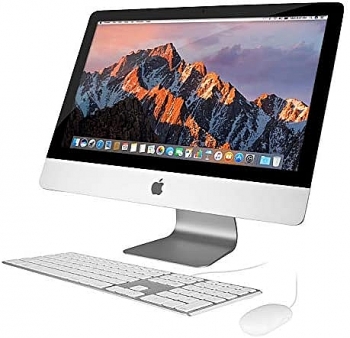 What is the first computer ever made in history? What is the first computer ever made in history? Compter has become one of the essential devices in daily affairs. Have you ever wondered about the history of the computer? What is the first ... |
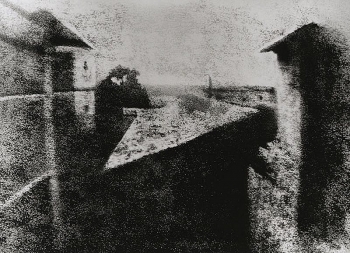 What is the First Photograph ever Taken In History What is the First Photograph ever Taken In History Have you ever been curious about the first photograph taken in the world? At KnowInsider, we let you know about the oldest photograph in the ... |
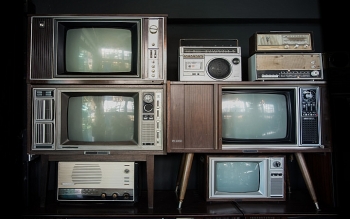 What is the first television in the world and who invented it? What is the first television in the world and who invented it? Evidently, television is one of the historic inventions in the world that allows us to get access to the information easily and conveniently. It takes ... |























